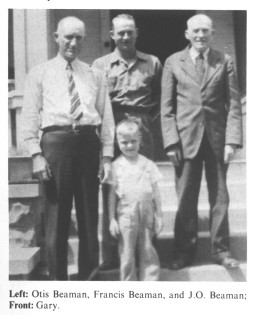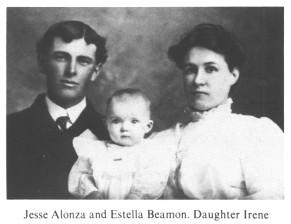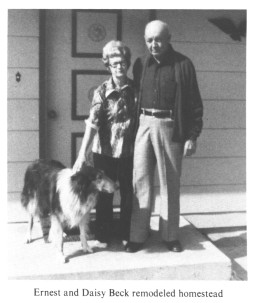 |
FAMILY STORIES |
 |
FAMILY STORIES |
|
despite their ages. Henry is well-known for his wire puzzle-making hobby. Henry celebrated his 90th birthday in February, 1983 with an open house at the Senior Citizens Center. We can rightfully be thankful and proud of this Czech heritage. Submitted by Daughters, Eleanor and Sophie JOSEPH B. BARTEKOur grandfather, born August 24, 1857 in Moravia, came to America with his parents, John and Vernonika (Plutenar) Bartek, in 1870. He was embarked on a ship for nine weeks, and came through Baltimore, Maryland. They came into Saunders County on an old ferry across the Platte River at North Bend. They were the first immigrants from Wallashko, Moravia.
They homesteaded in July, 1870. The family met all the experiences of hardships and privations of pioneer life. Knowledge of the carpenter's trade enabled him to cut timbers to make a dug out, the roof being covered with rails and thatch of slough grass. He earned money to buy boards and windows and household supplies. He cut his grain with a cradle scythe. After harvest, he walked to Omaha to work in building the foundation of the Union Pacific Railroad Bridge over the Missouri. He then bought two cows for milk for his family, and also, they served as his first team. In 1876, he built a log cabin. Two oldest sons, John and Joseph B., worked a whole year to get a yoke of steers. In 1880, John established a grocery and dry goods store in Weston. After good success for two years, he sold out. He was the first person to establish a home in the present town of Weston, which was platted 1877, and he started the Saint John Nepomuc Church in 1885. The first Mass was said on Dec. 8 by Fr. William Choka of Omaha. John returned to his farm and resided there until his death Dec. 29, 1891. Joseph B. had eight children. He supported his family and made his home with his parents until 1880. He got 160 acres, working it until 1891, when he was elected sheriff of Saunders County. The ninth child, Henry G., our father, was born in the living quarters of the jail. The family became big so they moved back to the farm. Joseph bought his first eighty acres in Newman Precinct for one thousand dollars. For the sum of three thousand dollars, he got the John Jamison ranch, and, five years later, got another eighty acres. He then owned three hundred and twenty-six acres of rich and valuable land. In 1894, he built a two-story house with a wind cave and stone wall cellar, six bedrooms, two closets upstairs, and a big basement barn for sixteen horses, with a granary, workshop, and big hay mow upstairs. There were outbuildings for shelter of grain and stock. The farm, well-watered, was on the south branch of Wahoo Creek, which had a lot of different kinds of trees. One cottonwood is more than twenty-seven feet in circumference, and more than one hundred years old. A windmill pumped water to stock. Large orchards, broom corn, and sorghum were raised. They made delicious molasses on a press. Grapes were used for homemade wine. Big gardens and farm animals, too, were common. Joseph B. was director of the Weston Grain and Stock Company. In 1890, he organized the first Independent Bohemian Paper in the United States. It was called "Pritel Lidu" which means "People's Friend." He was on the school board of Dist. No. 74. It was an honor for me, Miss Eleanor, to be born on the same farm. (See Chapmman Precinct for pictures of house and barn.) Submitted by granddaughters, Eleanor and Sophie MILO BARTEK FAMILYMilo, the son of Frank H. and Anna (Fiedler) Bartek, was born in rural Weston, Nebraska. Rose Marie (Pop) Bartek's parents are George and Rose (Tomsicek) Pop of rural Wahoo. Milo and Rose Marie were married February 15, 1949 in St. Wenceslaus Catholic Church at Wahoo, Nebr. Their children are: Robert -- Ithaca, Richard G. -- Ithaca, Rochelle -- Lincoln, Michael J. -- Ithaca, Nancy -- Lincoln, Tim -- Ithaca, and Robert and his wife, Mary (Sheridan), who have three sons, Christopher, Chad and Nicholas.
Milo serves as Supervisor of Saunders County, District 7. He and three of his sons are engaged in farming and cattle feeding south of Ithaca. BEACH-MEADIn the fall of 1972, we purchased from John Jess Saathoff, a quarter-section, formerly owned by Camerons. Art Stuart found some rough ground to pasture our quarterhorses for my first husband, Owen E. Beach, and me. Art was a friend of my father, Glenn A. Baldwin, doing business in the early '40's at General Tobacco and Candy Co. of Lincoln, Nebraska. Art owned the Phillips Service Station on Hwy. 77. We built a barn with an indoor riding arena the summer of 1973, then wintered a few head of horse on open pasture. We drove back and forth from home in Lincoln. We enrolled James B. Beach at Raymond Central High as a sophomore, and sister, Susan A. Beach, as a 7th-grader in the fall of 1975. Our home was completed Oct. 30, 1975. Our oldest daughter, Kimberly J., entered Kansas State University, graduating in 1977. She married Wayne Lee of Kansas City, Kansas, April 28, 1979. Son, Timothy O., left January, 1976, for school in San Marcos, California, Palomar College. He now lives in Vista. We enjoyed four world championships in reining on our show mares. Starting in 1969, our raising of quarterhorses has brought us some beautiful colts. I've also raised some Hereford, Angus, and Silver Gray cattle. I was remarried Jan. 9, 1982 to a college Ag major friend I knew some 32 years, Joel C. Mead. Joel was born in Beatrice, living on a farm at Western, Nebraska. His father, Joel Clark Mead, was born May 16, 1875, Webster County, Iowa, and died Febr. 19, 1947, at DeWitt, Nebraska. Mother, Gertrude Irene Pierce Mead, was born Oct. 19, 1887, at Big Springs, Texas, and died Febr. 28, 1944. I work at Miller & Vaine's, and sell water softeners for Ernie's Store. Joel works for a number of companies as manufactory representative, dealing with confinement furrowing operations in the U.S.A. He graduated in 1949 from Kemper Military School, Booneville, Missouri, and from UNL in 1953. He belongs to 1st U.S. Infantry Co., Commander, the Fremont Chamber Commerce, American Legion #3, American National Rifle Society, Alpha Gamma Rho Alumni, and is interested in hunting and fishing dogs. A daughter, Marcia Susan Mead, is a graduate of Fremont High, UNL, 1977, and lives in Lincoln. Sarah Ann Mead graduated from Fremont High, UNL, 1980, lived in St. Louis, Missouri, and works at the Mercantile Bank. Special events include my serving as president of National Association of Tobacco Distributors, Women's Division, March 1981; Jr. League of Lincoln; Admiral in the Nebraska Navy under Norbert Tiemann; Eastern Star Chapter 198; American Legion Auxiliary Unit 244; Better Halves extension club; Gamma Phi Beta Alumni, Pi Chapter; and starting a mobile library, July, 1975. I also served on Reading, Inc., and the Ceresco Community Building Committee, April, 1978. I was awarded a life membership of the library on Mar. 27, 1982. A family treasure is The Civil War Diary, 1861-63, by my great-grandfather, Cyrus F. Boyd, 15th Inf., Iowa, published by the U.S. Historical Society of Iowa. Submitted by Mary Belle Baldwin Beach-Mead CHAUNCEY E. BEADLEChauncey E. Beadle was born on March 24, 1867, in Kendallville, Indiana. His parents were Coleman and Adelaide Inman Beadle. His father was an old-fashioned peddler in Indiana. Chauncey came to Nebraska when he was 19 and worked on farms in Douglas and Saunders Counties.
In June, 1892, he married Hattie H. Albro in Galva, Illinois. They returned to Wahoo and farmed south of Wahoo. The Beadle farm was one mile south of town on the west side of the road, just south of the present Little residence. After 11 years at Wann, the Beadles moved back to Wahoo. The Beadles had three children. Alexander A. was born on April 22, 1896 and died on April 15, 1913 after being kicked by a horse. George W. was born in 1903 near Wahoo. He graduated from Wahoo High School, and studied at the University of Nebraska and Cornell University. After work at Harvard and Stanford Universities and the California Institute of Technology, he became president of the University of Chicago in 1961. In 1958, he received the Nobel Prize in medicine and physiology. He resides in California. Ruth Beadle, Chauncey's daughter, graduated from Cornell University in 1930. She taught nutrition in Oakland, California, where she now resides. page 184 |
|
Mrs. Beadle was a musician and an artist, painting with oils. Hattie died when the Beadle children were small. They were cared for by housekeepers. Chauncey's mother came to live with them and died in Wahoo on Mar. 12, 1915 at the age of 82 years, 2 months and 5 days. Chauncey died in Fremont on Mar. 4, 1959. THE BEAMAN FAMILY |
 |
| Left: Otis Beaman, Francis Beaman, and J.O. Beaman; Front: Gary. |
In 1820, John Ethell and his family moved to Boone County, Missouri, and were among the first to settle there. In order to make the trip to Missouri, John Ethell had borrowed a horse from his father, who later joined him in Missouri.
Benjamin Ethell was somewhat of an adventurer and was identified as one of the first settlers of Davis County, Iowa; although he did return to Missouri for a time where he married Sarah Jane Holmes in 1849.
His brother, Fielding, headed West during the Gold Rush and was later joined by brothers, George and David. Benjamin preferred the life of a farmer.
Tragedy struck in 1865 when his wife and five of his ten children died in Davis County, Iowa.
Still in search of the good life, he and his family moved to Saunders County in 1872, where they settled in Rock Creek Precinct, west of Ceresco.
Two of his sons, James and George, died in 1874 from typhoid fever. His daughter, Sarah Elizabeth Bennet, died in 1879. He later returned to Iowa to bring his mother to live with him. She died in 1882. Two years later, Benjamin Ethell died.
His daughter, Mary Ann, married James Orville (J.O) Beaman in 1879. The Beaman family had also lived in Davis County, Iowa, (J.O.'s father, Alonzo, had married Benjamin Ethell's sister after the death of his first wife) but had moved to Otoe County, Nebraska, in 1865, and remained there until J.O. and his brother, Ira, found their way to Saunders County in 1875.
J.O. farmed for forty years on land homesteaded by Benjamin Ethell in 1878 and then moved to Ceresco. His son Otis, continued the family tradition of farming. He married Edna Walter in 1906. They had three sons: Loren, Francis and Ivan. Ivan farmed for a short period of time, but Francis made it his career and farmed from 1934 to 1975.
My father, Francis, married Arvella Barger in 1935. My brother, Gary, and I are products of this union. Gary's children are Darrell, Shannon and Thad.
It was J.O. and Mary Ann Beaman who built the house now occupied by my parents. It is in this same house, filled with warm memories and history, that I look forward to visiting with my two daughters, Carolyn and Jodie. By Connie Beaman Wanek
Jesse Alonzo Beaman, born March 21, 1882 on a farm in Rock Creek Precinct, northwest of Ceresco, was a son of Ira Kelly Beaman and Mary Elizabeth (Buxton) Smith. He attended school at Eureka District 40, when it was located in center of Section 26, one-half mile from his home.
 |
| Jesse Alonza and Estella Beamon. Daughter Irene |
Jesse was second in a family of seven children. The others were C. Mabel, Sidney C., Lola May, Roy, Pearl Frances, Louise, who died in infancy, and a half-sister, Ida May Smith, who died when young.
Jesse's father, Ira, was born April 25, 1853 in Davis County, Iowa, a son of Alonzo and Elizabeth (Kelly) Beaman. His mother, Mary E., was born August 12, 1857, in Brooklyn, New York, a daughter of Samuel R. and Mary (Maginnis) Buxton. His grandfather, Alonzo, was born in Cincinnati, Ohio and grandmother, Elizabeth Kelly, was born in Kentucky. Alonzo served in both Mexican and Civil Wars.
April 16, 1902, Jesse married Estella L. Bennett, born November 29, 1882, a daughter of William Henry Bennet and Mary Elizabeth (Hurtt) Ingram. They settled on a farm near his parents' home; were parents of ten children, Irene, Erma, Lorene, Ileta, Earl, Dorothy, Edythe, Willard, Robert Elwin, and an infant. Four died in infancy.
He farmed until 1913, when he had a farm sale and moved to Ceresco, where he was a partner in the Gross and Beaman grocery and general merchandising store. He later moved back on the farm, continued farming and raising livestock until 1949, when he and his wife retired on the place where he was born.
He served on the District 40 school board. The school had been re-located one-half mile east of the original site in a new building. He was secretary of the Rock Creek Cemetery Association for 35 years.
He played snare drum in Ceresco Concert Band under the able leadership of Frank E. Hughes. An old-time fiddler, he played for many old-time dances in the area, accompanied usually by a banjo, organ, accordion, or second fiddle. An early custom was to have house or barn dances at the neighborhood homes. Entire families were invited. Children played games, while their elders enjoyed two-steps, waltzes, polkas and quadrilles.
There were no radios, televisions, or electricity on the farm at this time. Neighbors visited and exchanged work. Men were kept busy sawing wood for winter firewood, stacking hay, threshing grain, shelling corn, and putting up ice during winter months, storing it in a dug ice cave. There, large cakes of ice were packed with straw with an "A" shaped wooden roof to protect it from rain and summer heat. The women were kept busy preparing meals for the workers during these activities. Jesse lived to be 89 years and his wife, Estella, 82 years. Submitted by Erma (Beaman) Krone
The Beck family came to Saunders County in Nebraska back in 1887, when Valentine and his wife, Dora, and their son, Edward, came from Dover, Ohio. But originally they came from Germany. They had heard about the wonderful prospects in America from Dora's two brothers, Henry and Julius Holst. Both had their own businesses in Cedar Bluffs. Dora and Valentine decided to leave Dover, Ohio and come to Nebraska.
 |
| Ernest and Daisy Beck remodeled homestead |
They bought 80 acres in Pohocco Precinct. The ground had an original homestead house on it, but several rooms had been added. They bought a team of horses, with a few farm implements to farm the land. They planted the side-hill with grapes to make a vineyard, so they could sell their grapes door-to-door in Fremont. With a couple of milk cows and a few chickens they sold home-churned butter and eggs. By saving their money, and with a lot of hard work, they were able to pay the mortgage on the farm. Valentine was a carpenter. He built a new barn and other buildings.
In the meantime, Edward, who loved to read everything he could lay his hands on, had grown up and was a very handsome young man. He went courting in his horse and buggy, fell in love with a beautiful farm girl, Rosa Keller. They were married and bought a farm a mile west of the Beck farm. They were blessed with a son, Ernest, then a daughter, Mae, who died at birth, and Lucille, who was her father's pet. She was a lovely young lady, but passed away from diabetes very suddenly.
Just when Dora and Valentine had time to relax and enjoy life, he suffered a heart attack and died. But Dora was a very independent woman. She decided to stay on the old farmstead and still kept her milk cows and chickens.
In the meantime, Ernest, by now a handsome young man married Daisy Nelson, a country school teacher and they lived in Fremont. When Dora became ill, she had to leave the old farmstead and move in with her son, Ed, and wife, Rosa, where she lived until she passed away a few years later.
Ernest and his wife, Daisy, moved on the Beck farm. They also worked hard, raised a lot of livestock, milked a lot of cows and raised chickens. They raised four wonderful children, Robert, Bette, Jean, and Donald. They were all very active in 4-H and worked their way through college.
In the meantime Ed and Rosa moved to Cedar Bluffs to care for her parents, Paul and Veronica Keller. The Kellers passed away soon after that, but Edward and Rosa lived to celebrate their 50th and 60th anniversaries.
The Ernest Beck family were soon the only Becks left, their four children all married. Now there are 15 Beck grandchildren and 15 great-grandchildren. Ernest and Daisy completely remodeled the old homestead and celebrated their 50th Anniversary.
page 185
| Back | Family Index | Contents | Next |